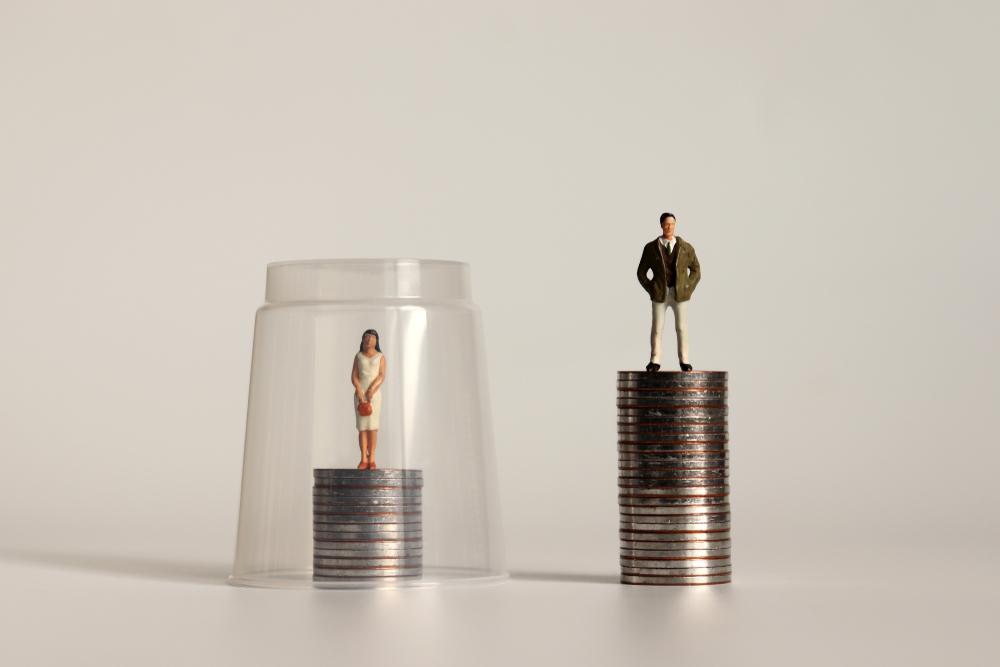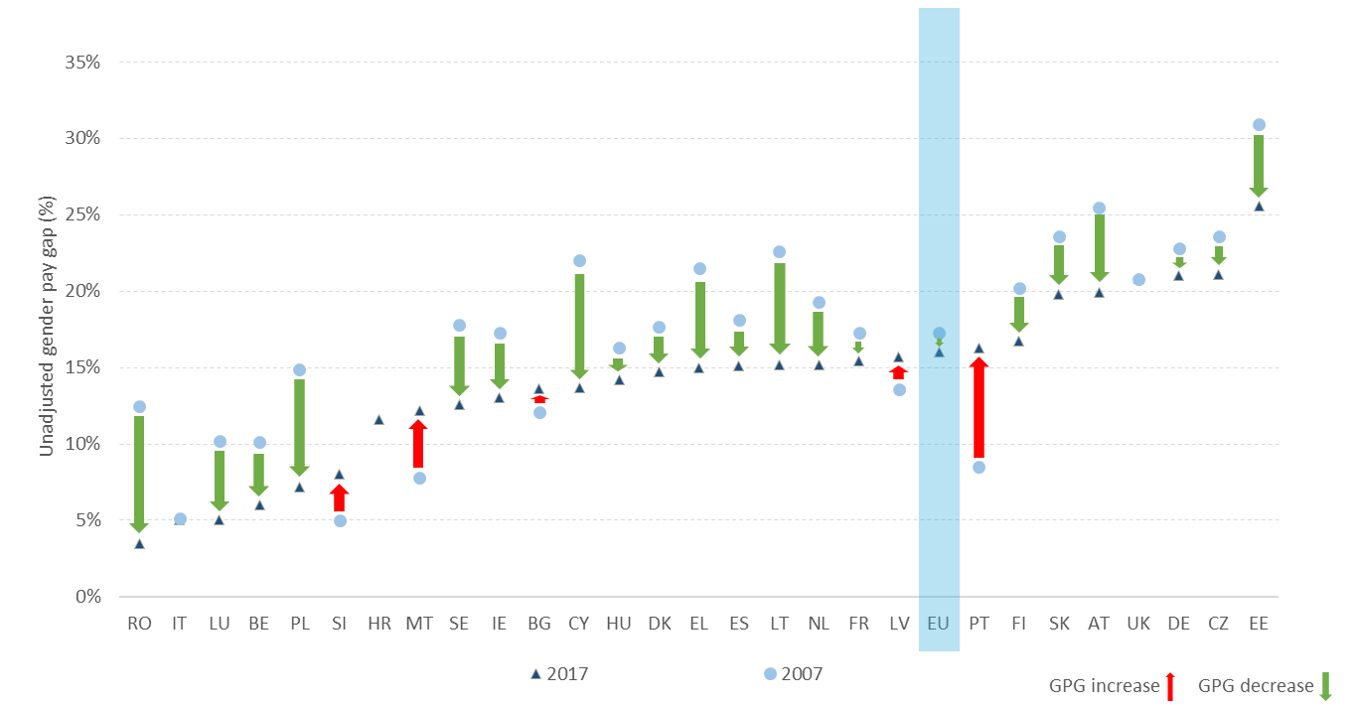
The gender pay gap in the EU stands at 16 % and has barely changed in the last decade. In most EU countries, the gender pay gap is slowly reducing but in Malta, Portugal and Slovenia, the gap has increased by more than 3.0 % since 2007. There are big differences across the EU, with the gender pay gap ranging from 3.5 % in Romania to 25.6 % in Estonia. The awards for the smallest pay gaps go to Belgium, Italy, Luxembourg, Poland, Romania and Slovenia, where the gap is smaller than 10.0 %. The most room for improvement is in Czechia, Germany, Estonia and United Kingdom where the gap is more than 20 %.
This is the story that data tells about the gender pay gap and the economic situation of women across the EU, mainly based on data from 2018:
- A low gender pay gap does not necessarily indicate more gender equality. Rather, a lower gap can be a consequence of lower labour market participation of women. 68.2 % of women across the EU are active in the labour market compared to 79.2 % of men.
- However, lower pay gaps seem to have a connection with labour market participation. Data shows that in Member States with small gender pay gaps, women aged 20-64 have lower employment rates than men. In Italy, where the gap is 5.0 %, the employment rate for women is 53.1 % compared to 72.9 % for men. In Romania, where the gap is 3.5 %, 60.6 % of women are employed compared to 78.9 % of men. In Member States with larger pay gaps, women’s employment rates are higher, such as in Germany and Estonia, where the employment rate for women is 75.8 % and 75.6 % respectively compared to 83.9 % and 83.4 % respectively for men.
- In some countries, small gender pay gaps can be explained by the level of education of employed women. Higher educational attainment is associated with higher wages. This is very prominent in Romania, where the proportion of highly educated women in employment is 86.4 %. This rate is much higher than the 32.0 % employment rate for women with lower education. As a result, women’s average pay is skewed towards pay of women with higher educational attainment. This means that a relatively small proportion of highly educated women make the average wage for all women seem high and actually close to the level of men’s wages. The low gender pay gap also hides the fact that women with lower educational attainment are often being excluded from the labour market.
- Another reason behind the gender pay gap is that, on average, women spend fewer hours in paid work than men. This is the situation in all Member States, except for Bulgaria, Czechia, Greece, Croatia, Hungary, Poland and Romania. In the EU, the average number of weekly working hours for men is 40 hours, compared to 34 hours for women.
- In 2015, women in all Member States, except Bulgaria and Czechia, spent more time on cooking and housework than men. Women in Italy, Cyprus, Malta and Poland spent the most time: up to 3.2 hours per day. Women in France, Finland and Sweden spent the least time: 1.9 hours per day.
- Additionally, women are primary carers, which leads to lower employment rates for mothers than for fathers with young children in all Members States. The average employment rate for mothers aged 20-49 with a young child (younger than 6 years old) is 65.4 % in comparison to 91.5 % of fathers.
- 15.0 % of 15-to-64 year old inactive women are inactive for care reasons, i.e. looking after dependents (children or incapacitated adults), compared to only 1.4 % of men.
- Women are more likely to have non-standard work contracts, which are associated with lower pay. Data shows that in 22 out of 28 Member States, women are more likely than men to work in temporary contracts. On average, 12.7 % of women work in temporary contracts in the EU, compared to 10.7 % of men.
- More women than men also work part-time: 31.3 % of women in the EU work part-time, in comparison to 8.7 % of men. There is a considerable variation between the Member States. The rate in most Central-Eastern European countries – Bulgaria, Croatia, Lithuania, Latvia, Hungary, Poland, Romania and Slovakia – does not exceed 10.0 %, whereas more than 39.0 % of women in some Western European countries – Belgium, Germany, Netherlands, Austria and the United Kingdom – work part-time.
- The low proportion of women employees in managerial positions also contributes to the gender pay gap. In all Member States the proportion of women in managerial positions is lower than that of men. Data shows that women are systematically under-represented in decision-making positions: in the first half of 2019, on average, women accounted for only 6.9 % of CEOs, 17.6 % of executives, and 30.4 % of non-executives. In addition, women managers working in companies with 10 or more employees are paid less than men in all Member States. Women managers in the EU earn ten euros less than men per hour.
- These financial inequalities over the lifetime contribute to an even bigger gender pension gap. Data shows a higher risk of poverty for women pensioners in most Member States. The risk of poverty is highest in Bulgaria and the Baltic countries, ranging from 59.0 % in Estonia to 34.1 % in Bulgaria, compared to 43.1 % to 20.0 % for men in the same countries.
Figure: Unadjusted gender pay gap* in 2017 and change since 2007, EU-28

Source: EIGE Gender Statistics Database - Gender pay gap (GPG)
Note: Data for the EU average refers to 2008 instead of 2007 due to missing data in 2007. Data for HR missing for 2007. Data for IE for 2017 refers to the most recent data for this country from 2013
*The unadjusted Gender Pay Gap that represents the difference between average gross hourly earnings of male paid employees and of female paid employees as a percentage of average gross hourly earnings of male paid employees. The population consists of all paid employees in enterprises with 10 employees or more in NACE Rev. 2 aggregate B to S (excluding O) - before reference year 2008: NACE Rev. 1.1 aggregate C to O (excluding L) – retrieved from https://eige.europa.eu/gender-statistics/dgs/indicator/eustrat_sege1619…
EIGE’s Gender Statistics Database includes a dedicated section on living conditions and work and labour market of women and men.